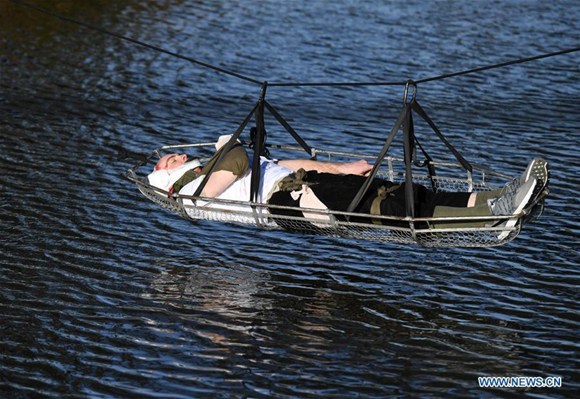
An American soldier participates in a drill at Camp Rilea in Seaside of Oregon, northwest United States, Nov. 18, 2017. The Chinese and U.S. militaries were holding the 5th joint drills on humanitarian relief and disaster rescue in Oregon. (Xinhua/Yin Bogu)
Over a "river" that cuts off a road in a "flooded city," an injured victim bound tightly to a stretcher was slid on a rope bridge from one side of the "river" to safety on the other side in a simulated disaster relief operation here Saturday.
The rope bridge erected by a group of Chinese and American soldiers became the only tool that shipped the victim covered with a blood-soaked bandage under a survival blanket, who was played by specialist Glen Rathwick from the U.S. army, to a safe place across the "river" in a joint drill where the Chinese and American soldiers worked together to respond to a simulated humanitarian disaster in a third country.
The field drill, which entered its fourth day after a three-day academic seminar and table-top exchange, was part of a week-long joint humanitarian and disaster relief exercise and seminar in Portland, Oregon in western United States.
The Chinese and U.S. soldiers worked in close cooperation to treat "injured victims" with patience and tacit understanding, though they did not know very much about each other's language.
"The medical personnel were good and knew what they were doing," said Rathwick.
"Felt the treatment was speedy and caused no further pain than necessary," he added, "I felt in safe hands."
He went on to say that it was good coordination from both sides when the soldiers from U.S. and Chinese armies came together to work on a same task.
While saving a victim suffering a broken neck and with weak life signs, a Chinese female army medic told him in soft and gentle tone: "Don't worry, you'll be OK."
She quickly fixed his legs and arms with aluminum splints before she asked her colleagues to take him away for further treatment.
The young soldiers from Chinese and U.S. armies came from different places and had totally different experience in response to real-world disasters, but they learned to team up quickly in the joint training.
"But after a few days, we were on the same page," said Staff Sergeant Daniel Schluter.
On another front was a simulated urban area flattened by a strong earthquake, where a bridge was pulled down and two private cars were buried under the rubble.
A team of Chinese and American soldiers were practicing to dig deep into the debris in order to find any possible life underneath.
A huge bulldozer and large cutting tools were employed, and the soldiers' faces were all wet with sweat, with roaring sounds coming from working rescue machines operating behind.
"This is a cement steel structure. Such large-scale equipment was used in rescue operations, most often by U.S. soldiers. While we were from China's southern part, we used more handy tools in enclosed-space rescue," said Wang Runze, a corporal from the Southern Theater Command of the People's Liberation Army (PLA) of China.
The joint training provided a very good opportunity for both sides to learn from each other, he said.
At one point when they combed through a collapsed building, they would make a mark or sign that is universally recognizable on the surface of the structure after they finished their search, so that their fellow soldiers would not waste their precious rescue time in doing the same search.
He said American soldiers were puzzled about those signs and asked Wang about the reason, and the Chinese soldier explained in detail the no-more-searching sign to his American peers.
"The American soldier nodded in agreement and said it's very interesting and worth learning by the American Army," Wang smiled, beaming with a sense of pride.
"The Chinese soldiers were very professional and disciplined," said Staff Sergeant Newsburry Virgil from U.S. National Guards.
"I was fascinated by the Chinese soldiers, and they wasted no moment in the rescue," he added.
"Their coordination is almost perfect, and they know how they would make a team," Virgil noted, referring to his experience with the Chinese soldiers in the relief and rescue operation.
The joint training between Chinese and American troops has given him a valuable chance to learn how to respond to natural disasters, since he has never participated in rescue of any real-world calamities.
"I wanted to be part of the history," he said.


















































